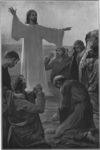
The noun ‘gospel’ is a term that has been bandied around and applied in so many different ways in today’s evangelical churches that it has practically lost its meaning. This page seeks to give a clear biblical definition of the gospel, describe its immediate historical reception and nuance its relationship to salvation.
What is the gospel the apostles preached?
Understanding what the gospel is, is probably the most important question we can ask as Christians. It informs what Christians ought to believe to be saved, it is how we grow in Christian maturity and it is the churches source of unity.
Contents
Etymology
In Koine Greek the noun εὐαγγέλιον transliterated as euangélion is derived from εὖ eû “good” + ἄγγελος ángelos “messenger”.
Hundreds of years later, with translation of the New Testament into Old English, euangélion was rendered as gōdspel from c.e. 500 onwards.
“Gōd” meaning “good” and “spel” meaning “story”, “tale”, “narrative” or “news”. (https://www.etymonline.com/word/spell)
The Old English term was retained as gospel in Middle English Bible translations and hence remains in use also in Modern English.
Old Testament
In the Old Testament ‘good news’ frequently denoted the message of victory in battle which resulted in a king coming to power or maintaining their reign. The news was called ‘good’ because it was news of victory for their side.
31 And behold, the Cushite came, and the Cushite said, “Good news for my lord the king! For the LORD has delivered you this day from the hand of all who rose up against you.” (2 Sam 18:31; cf. 1 Chr 10.9; 1 Ki 1.42)
In Isaiah the good news proclaimed the victory of God over Israel’s enemies;
9 Go on up to a high mountain, O Zion, herald of good news; lift up your voice with strength, O Jerusalem, herald of good news; lift it up, fear not; say to the cities of Judah, “Behold your God!”
10 Behold, the Lord GOD comes with might, and his arm rules for him; behold, his reward is with him, and his recompense before him.
11 He will tend his flock like a shepherd; he will gather the lambs in his arms; he will carry them in his bosom, and gently lead those that are with young. (Isa 40:9–11)
7 How beautiful upon the mountains are the feet of him who brings good news, who publishes peace, who brings good news of happiness, who publishes salvation, who says to Zion, “Your God reigns.”
8 The voice of your watchmen—they lift up their voice; together they sing for joy; for eye to eye they see the return of the LORD to Zion.
9 Break forth together into singing, you waste places of Jerusalem, for the LORD has comforted his people; he has redeemed Jerusalem.
10 The LORD has bared his holy arm before the eyes of all the nations, and all the ends of the earth shall see the salvation of our God. (Isa 52:7–10)
We can see from these early OT examples the ‘good news’ denoted the military victory of a king over some opposing power. It wasn’t intended to be good news for all, rather for the winning side. The victory established his rule over the kingdom and the salvation (deliverance) of his people.
Greco-Roman Context
Similarly ‘good news’ in the Greco-Roman context commonly denoted the coming to power of an emperor, beginning from his birth and especially his victory over foreign powers, again establishing his kingdom and bringing salvation for his people.
‘But the birthday of the god was the beginning of the good news, on his account, for the world’ (inscription) When news spread of Vespasian’s accession to the throne, ‘every city celebrated the good news and offered sacrifices on his behalf’ (Josephus, War 4.618).
‘On reaching Alexandria Vespasian was greeted by the good news from Rome and by embassies of congratulations from every quarter of the world, now his own … The whole empire being now secured and the Roman state saved beyond expectation’ (Josephus, War 4.656-657).
Early Christian Usage
Jesus and his disciples preached the gospel. The gospel they preached concerned the kingdom of God.
14 Now after John was arrested, Jesus came into Galilee, proclaiming the gospel of God, 15 and saying, “The time is fulfilled, and the kingdom of God is at hand; repent and believe in the gospel.” (Mk 1:14–15)
23 And he went throughout all Galilee, teaching in their synagogues and proclaiming the gospel of the kingdom and healing every disease and every affliction among the people. (Mt 4:23)
(See also Mt 9.35; 24.14; Lk 4.43; 8.1; 16.16)
From early Christian usage and what we have seen of the Old Testament and Greco-Roman context, the common theme of the ‘good news’ concerns the kingdom.
The gospel Jesus and his disciples preached was about the kingdom of God with Jesus as its king.
Only one Gospel (Gal 1.6-7)
After Jesus rose from the dead and ascended, we should note Paul says in Galatians, there is only one gospel (Gal 1.6-7). But at the same time there are numerous varied references to the gospel and examples of people preaching the gospel.
Thus at this point I would like to show from a series of references what is;
- Common to each (necessary), and
- Unique to particular sermons (optional).
Primary text (1 Cor 15.3-5, 22-25)
I believe 1 Corinthians 15 is the best and clearest outline of the apostolic gospel in the bible. I’ve categorised its content using different colors.
“Now I would remind you, brothers, of the gospel I preached to you, which you received, in which you stand, and by which you are being saved, if you hold fast to the word I preached to you—unless you believed in vain. For I delivered to you as of first importance what I also received:
that Christ died for our sins in accordance with the Scriptures,
that he was buried,
that he was raised on the third day in accordance with the Scriptures, and
that he appeared to Cephas, then to the twelve. …For as in Adam all die, so also in Christ shall all be made alive. But each in his own order:
Christ the firstfruits, then at his coming those who belong to Christ. Then comes the end, when he delivers the kingdom to God the Father after destroying every rule and every authority and power. For he must reign until he has put all his enemies under his feet.” (1 Cor 15.1-5, 22-25)
Breaking it down into various parts here are some observations from the text.
- The gospel declares Jesus is the ‘Christ’. The Christ is the promised King who would fulfill God’s promises and prophecies about the coming kingdom of God.
- The gospel is a sequence of events in Christ’s life. His death, burial, resurrection, appearances/witness and second coming (‘Christ’, Sequence of events).
- The gospel is connected chronologically to the Old Testament (‘according to the scriptures’). This includes the story of creation and Israel, the promises and prophecies predicting the coming of God in the person of the Christ who would suffer, die, rise again and usher in his eternal kingdom.
- Paul says Christ died for our sins. What Christ has done has implications for us and our salvation.
The Apostles preached the gospel in Acts
I assume outright the apostles preach the gospel in Acts. However, I cannot be sure where. Their messages may contain the gospel, but we should not assume everything they say is the gospel.
In my series I compare each of the sermons with 1 Cor 15.3-5,22-25 to verify whether they contain the Paul’s understanding of the gospel or not. Below are the Acts sermons that most closely resemble 1 Cor 15.3-5, 22-25.
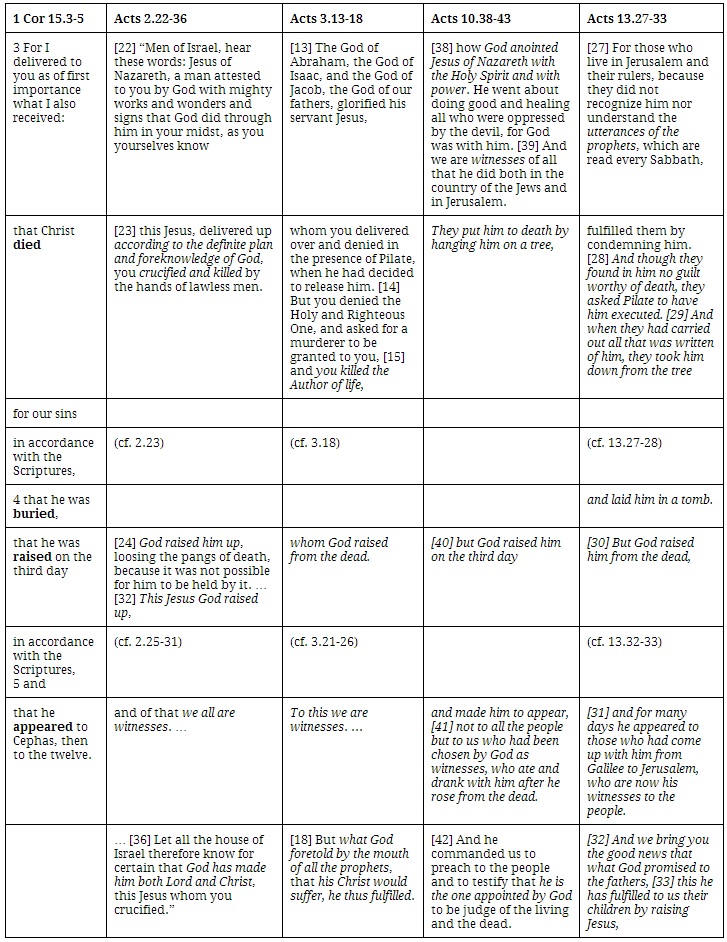
Structure of the Gospel
References to Jesus’ death on the cross, his resurrection on the third day, and his appearances to witnesses are clearly common to all the messages.
Its clear from the apostles sermons they relate the death, burial, resurrection and appearances of Jesus in story form. Remember in Old English ‘gospel’ means good story.
Only Paul refers to Jesus’ burial in his sermon in Acts 13. So its hard to argue it is necessary. But it is part of the narrative.
Peter and Paul refer to Jesus’ second coming to judge in Acts 17 and 10. See also Romans 2.16;
according to my gospel, God judges the secrets of men by Christ Jesus. (Rom 2.16)
Again this is not in all gospel sermons. But it also is part of the wider narrative. Looking to the future.

There is no such thing as a gospel presentation that does not recount (in broad terms at least) the narrative of Jesus’ life. (Dickson, J., The Best Kept Secret of Christian Mission: Promoting the Gospel with More than Our Lips, Review)
According to the Scriptures
A clear aspect of each of these messages are quotations from the Old Testament proving Jesus is the Christ (‘according to the scriptures’). The following verses highlight this aspect of the gospel message.
32 And we bring you the good news that what God promised to the fathers, 33 this he has fulfilled to us their children by raising Jesus, (Acts 13:32–33)
2 And Paul went in, as was his custom, and on three Sabbath days he reasoned with them from the Scriptures, 3 explaining and proving that it was necessary for the Christ to suffer and to rise from the dead, and saying, “This Jesus, whom I proclaim to you, is the Christ.” (Acts 17:2–3)
8 Remember Jesus Christ, risen from the dead, the offspring of David [according to the scriptures], as preached in my gospel, (2 Tim 2.8)
1 Paul, a servant of Christ Jesus, called to be an apostle, set apart for the gospel of God, 2 which he promised beforehand through his prophets in the holy Scriptures [according to the scriptures], 3 concerning his Son [story of Jesus], who was descended from David according to the flesh 4 and was declared to be the Son of God [Jesus declared the Christ] in power according to the Spirit of holiness by his resurrection from the dead, Jesus Christ our Lord (Rom 1.1-4)
Died for our sins
Its apparent from the structure of 1 Cor 15.3-5, the content of the gospel message is not structured around the concepts of atonement and forgiveness or any other allusion to salvation. Rather the structure follows the narrative of Jesus’ birth, life, death and resurrection. However the gospel events certainly have saving significance.
In most messages in Acts which include the narrative there are differing allusions to salvation. These include, but are by no means limited to forgiveness (Acts 10,13) and justification (Acts 13). Because none of these allusions to salvation are common for all the messages –
No one allusion to salvation can be deemed a necessary part of the gospel (e.g. God’s wrath at sin, Justification, forgiveness).
Peter says Jesus came to give repentance to Israel and forgiveness of their sins (Acts 5.31). When Peter preached to the Jews who crucified Jesus he urged them to repent of their sin (Acts 3.19) and be baptised (Acts 2.38).
When the apostles caught people in sin, they urged them to repent of that sin. If they did not believe their audience had sinned in some way they did not urge them to repent (e.g. Acts 10,13).
Matthew, Mark, Luke, and John are the Gospel
The Christian Church has traditionally named the bibliographies or narratives of Jesus life, death, burial and resurrection;
- ‘The gospel according to Matthew’,
- ‘The gospel according to Mark’,
- ‘The gospel according to Luke’, and
- ‘The gospel according to John’.
The Gospel according to Mark reinforces this point and starts with
‘in the beginning of the gospel of Jesus Christ, the Son of God.’ (Mk 1.15)
And then goes on to narrate the life, death and resurrection of Jesus.
 The author of Mark starts his bibliography of Jesus this way because he believes what he is writing is the Gospel.
The author of Mark starts his bibliography of Jesus this way because he believes what he is writing is the Gospel.
Likewise in the Gospel according to Matthew, Jesus defends the actions of a woman preparing him for his death by referring to his life and ministry as the gospel saying;
“Why do you trouble the woman? For she has done a beautiful thing to me. 11 For you always have the poor with you, but you will not always have me. 12 In pouring this ointment on my body, she has done it to prepare me for burial. 13 Truly, I say to you, wherever this gospel is proclaimed in the whole world, what she has done will also be told in memory of her.” (Mt 26.10-13)
I say all this because some might think there are two kinds of gospel. These being
- The narrative of Jesus’ life, death and resurrection (Matthew, Mark, Luke and John) and
- Some sort of message about people being sinners and needing salvation.
This is a mistake because as I’ve already stated, Paul says there is only one gospel (Gal 1.6-9).
I acknowledge, there are many variations of that one gospel. The Gospels according to Matthew, Mark, Luke, and John, Acts 2.22-36, Acts 3.13-18, Acts 10.38-43, Acts 13.27-33, and 1 Cor 15.3-5,22-28 all describe the same story of Jesus, but each are unique in their own way. The story of Jesus is common to all.
Note: As mentioned before Jesus and the disciples are described as preaching the gospel when they announced the coming kingdom of God and Jesus as king as the Old Testament had led Israel to expect. After Jesus died and rose again the gospel was able to build on the theme of the kingdom of God (e.g. Acts 20.25), Jesus life, death and resurrection inaugurated the kingdom of God.
The whole Gospel story has many features and provides a wealth of material that can be used for evangelism, discipleship, comfort, teaching and correcting (1 Cor 15; Mk 1.14-15; Mt 26.6-13; Rom 1.16-17; 2 Tim 2.8).
- Genealogy
- Prophecy fulfilled
- Jesus’ authority
- Over Creation,
- To Forgive Sin,
- To Teach,
- To Instruct and Command,
- Over Sickness and Over People
- Declares Jesus as the Christ
- Future Prophecy and Judgment
- Repentance
- Faith
- Commissioning
- Parables
- Miracles
- Law of Moses
- Conflict
- Lords Supper
- Passion, Death on the Cross, Burial, Resurrection and Appearances
One point in highlighting this is that the gospel does more than bring about conversion, it is how God’s people are to be discipled as well. Paul says in 1 Cor 15.2, ‘the gospel … by which you are being saved’. ‘Being saved’ (Gk. σῴζεσθε, Trans. sōzesthe) is in the present tense denoting discipleship and growth in maturity worked through ongoing exposure to the gospel. This is the core element in what I think of as the process of salvation.
The bibliographies of Jesus were called the gospel by the early church because they believed they were the gospel.
If we looked at the entire New Testament, the contents of the gospel the apostles preached is most clearly reflected in these texts.
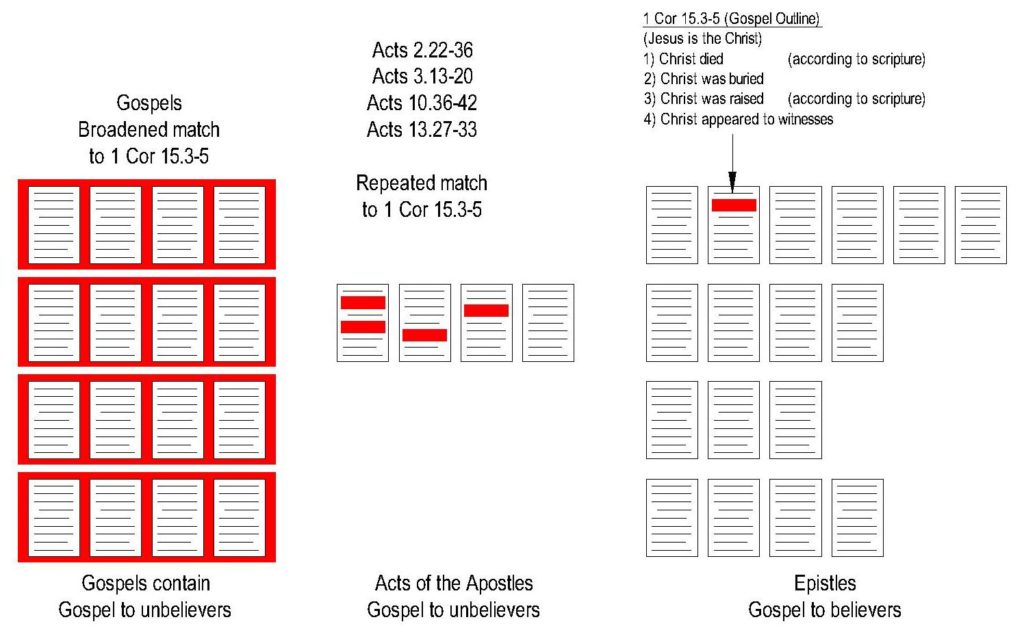
There is only one gospel, and the story of Jesus is what is in common to all passages referring to the gospel in the New Testament.
Early Church Fathers
Here are some quotes from the early church and their understanding of the gospel.
“Papias (c. 60-130) was an early bishop of Hierapolis and a disciple of those who knew the apostle John.
He insists the Gospel of Mark and the Gospel of Luke contained the very gospel message preached by Peter and Paul respectively.
He informs us Mark had been apostle Peter’s personal assistant. After the apostles death Mark put into writing all that he could recall of Peter teaching, being careful ‘to leave out nothing of what he had heard and to make no false statements’. The result was what we call the Gospel according to Mark.”
(Dickson, J., The Best Kept Secret of Christian Mission: Promoting the Gospel with More Than Our Lips, Loc 2041 of 3524)
The next quote is from an early church father named Ireneaus (c. 130-202)
“For, after our Lord rose from the dead, [the apostles] were invested with power from on high when the Holy Spirit came down [upon them], were filled from all [His gifts], and had perfect knowledge: they departed to the ends of the earth, preaching the glad tidings of the good things [sent] from God to us, and proclaiming the peace of heaven to men, who indeed do all equally and individually possess the Gospel of God.
Matthew also issued a written Gospel among the Hebrews in their own dialect, while Peter and Paul were preaching at Rome, and laying the foundations of the Church.
After their departure, Mark, the disciple and interpreter of Peter, did also hand down to us in writing what had been preached by Peter.
Luke also, the companion of Paul, recorded in a book the Gospel preached by him.
Afterwards, John, the disciple of the Lord, who also had leaned upon His breast, did himself publish a Gospel during his residence at Ephesus in Asia.”
(Ch 1, Ireneaus, Against Heresies, Book III, Ante-Nicene Fathers Volume 1 – Enhanced Version (Early Church Fathers)
More well-known is Augustine of Hippo.
This was Paul’s gospel; and it was also the gospel of the other apostles, and of all faithful stewards of so great a mystery. For Paul says elsewhere, “Whether, therefore, I or they, so we preach, and so ye believed.” (1 Cor 15.11) They did not all write the gospel, but they all preached it.
The name evangelist is properly given to the narrators of the birth, the actions, the words, the sufferings of our Lord Jesus Christ.
The word gospel means good news, and might be used of any good news, but is properly applied to the narrative of the Saviour.
If, then, you teach something different, you must have departed from the gospel. (Ch 2, Book 2, Against Faustus)
And lastly Chrysostom;
We assert, therefore, that, although a thousand Gospels were written, if the contents of all were the same, they would still be one, and their unity no wise infringed by the number of writers. So, on the other hand, if there were one writer only, but he were to contradict himself, the unity of the things written would be destroyed. For the oneness of a work depends not on the number of its authors, but on the agreement or contradictoriness of its contents.
Whence it is clear that the four Gospels are one Gospel;
for, as the four say the same thing, its oneness is preserved by the harmony of the contents, and not impaired by the difference of persons. (John Chrysostom, Commentary on Galatians, Gal 1.6)
The Gospels are called the gospel because they are the Gospel.
The early church understood the gospel to be the narrative of Jesus’ birth, life, death, burial and resurrection. This narrative is encoded in the earliest expressions of the gospel in the 1 Cor 15.3-4, apostolic and nicene creeds.
This narrative concerns the saviour. The one who brings salvation. This can be supported from a few hundred quotations from the early church and indeed this view has continued in the church and has borne amazing fruit for approximately 2000 years to this day.
- The gospel names Jesus as the Christ. The Christ is the promised King who would fulfill God’s promises and prophecies about the coming kingdom of God.
- The gospel narrates a sequence of events in Christ’s life. His death, burial, resurrection, appearances/witness, ascension, second coming and judgment (‘Christ’, Sequence of events). To share the gospel like the apostles do one must relate these elements in story form.
- The gospel is connected to the Old Testament (‘according to the scriptures’). This includes the story of creation and Israel, the promises relating to Salvation, the Holy Spirit and the blessing of the Gentiles, the prophecies predicting the coming of God in the person of the Christ who would suffer, die and rise again and the reign of his eternal kingdom.
- The gospel brings about salvation for the people who recognise Jesus as king.
I can capture many of these in a diagram about salvation history.

I’m not saying anything new about the gospel.
Rather I am showing from the bible and the early church what Christians have always believed the gospel is.
What is the Gospel?
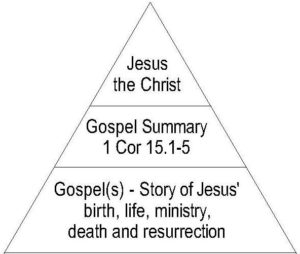 The Gospel is primarily about Jesus Christ. He literally is the ‘Word of God’ (Jn 1.1f). The divine message.
The Gospel is primarily about Jesus Christ. He literally is the ‘Word of God’ (Jn 1.1f). The divine message.
The Gospel tells the story of His birth, life, ministry, death, burial, resurrection, ascension and coming judgment in order to declare him Lord and Saviour.
The Gospel has its background in the Old Testament scriptures which promise and predict the coming of God in the person of Christ.
The Gospel story is to be interpreted as a blow by blow description of Jesus’ victory over sin, death and the evil powers of this world, with the focal point being Christ’s atoning death on the cross – thereby establishing his kingdom and the salvation of all people who have turned to him and believe He is their Christ and king.
The Gospel calls all people to turn to Jesus as Lord and Saviour and give him their trust and allegiance.
The Gospel is good news because Jesus has won, He is with us and now reigns.
I believe the telling of His story can be done (and was done by the apostles and the early church) in such a way that it saves, disciples, corrects, warns, educates and gives hope to its listeners.
Common Misunderstandings
I’ve read a number of arguments for and against what I have presented as the gospel above. What I say about the common misunderstandings below is specifically directed to address criticisms of what I’ve argued. I have to write this to defend what I believe is the gospel.
I think in some Christian circles salvation is given priority over Jesus. I think this puts emphasis in the wrong place.
I seek to reverse this order of priority. The gospel is primarily about God’s Son (Rom 1.3). Which means talking about Jesus is more important that talking about personal salvation.
I’m not denying the importance of salvation. Rather I’m putting salvation in what I believe is its right place and I’m increasing the range of applications of the gospel. As I mentioned previously, the gospel is intended to do more than facilitate conversions, it is to be used throughout the Christians life to disciple them to be followers of Jesus, continually growing in maturity to be more like Him.
With this in mind I’ll list a few misunderstandings I believe can be made about the relationship between the gospel as the story of Jesus and personal salvation.
Misunderstanding 1 – Making salvation more important than Jesus. The Gospel saves and this is a wonderful fact! However I wonder if some get so obsessed with the salvation of sinners they ignore the fact the gospel is the story of Jesus (cf. Mk 1.1). Jesus is marginalised and the message becomes story-less. Sometimes the message is Jesus-less.
Quite often the gospel is reduced to a series of pithy and abstract propositions. The gospel is more than propositions. The gospel consists of sentences. Its a narrative. Yes there are true statements. But in the gospel (the story of Jesus) I see some asking questions, even making dumb statements that need to be corrected.
Stressing matters of importance does not give a license to distort biblical truth. The gospel is what the scripture says it is no matter how important salvation is.
The more Jesus is taken out of the gospel message and emphasis given elsewhere the less it is the apostolic gospel. There is simply no basis for calling a message ‘the gospel’ if Jesus, his words and deeds are not given primary attention throughout the whole message.
Why is it we rarely ‘gospel’ people with any of the four gospels? Why is so much gospel preaching focused on people and their need? Could this be one of the reasons why so much evangelistic preaching today is so powerless to change lives? Because it is not God’s gospel!? (p18, Chapman, J., Know and Tell the Gospel)
Also how else are people to believe in him if they don’t know who he is? The gospel reveals Jesus to the audience and gives them a chance to make up their opinion about him. To get to know him as their Lord and Saviour.
Misunderstanding 2 – Why is the good news ‘good’?
Some might argue “the good news is called ‘good’ because it offers forgiveness, acquittal from judgment and salvation”. “The gospel cannot be considered ‘good’ unless it does something good for us.” “The Jesus is Lord is not good news, its terrifying because we are under his judgment”. This is a very self centered understanding of the gospel, which moves the focus of the gospel from Jesus to us and our personal salvation.
From initial references we see from the Old Testament, just because the news was called ‘good’ did not necessarily mean it was interpreted as good for all. It was only good for the winning side.
The gospel is ‘good news’ because delivers to us what is our highest good. The person and presence of King Jesus who now rules over his kingdom. The good news is ‘good’ because we come into his presence. Revelation communicates this message of comfort: Jesus your King is with you. Jesus has won. Knowing and being with Jesus is more important than anything. Again I’m making a value statement: Jesus is more important than salvation.
It is true that this is not good for all people. But Paul would agree, the good news is only good for those who believe (2 Cor 2:12–16).
Misunderstanding 3 – Ignoring important distinctions. Some might say I’m too sharply distinguishing the story of Jesus from salvation, or the historical events of the gospel from their theological significance – that is to say these cannot be separated.
In response to this objection I take the same point further. There are aspects which cannot be separated from the Story. Yes, salvation is one of them.
But I believe there are a lot more things than salvation that cannot be separated from the story. When I examine the sermons in Acts or the letters of Paul or even the preaching of Jesus, I see the Story of Jesus deeply intertwined with lots of concepts.
For example; I see the story of Jesus includes the early ministry of John the baptist (e.g. Mk 1.2-8; Acts 10.37). I see the gospel proving that Jesus is the promised Davidic messiah (e.g. 2 Tim 2.8; Lk 1.26-33). I see the gospel combined with teachings about the coming resurrection (e.g. 1 Cor 15.12f; Lk 20.27-40). In the gospel I see Jesus demonstrating his authority over creation, to heal, to cast out demons to command. There’s lots more than this! The story cannot be separated from a great many things.
On the other hand I recognise making distinctions can be important in some situations. Why is making a distinction between the story and all the elements inseparably connected to it important? I believe its important because it ensures Jesus and his story get proclaimed in each and every gospel sermon and it gives the flexibility to preach all the other aspects in addition to salvation combined with the story as need requires.
Misunderstanding 4 – Ignoring other functions of the gospel. Quite often it is assumed the gospel can only do one thing. To turn people to God and therefore bring about salvation.
The apostles certainly use the gospel to turn people to God (repent) and bring about salvation in Acts. Undeniable. Wonderful. In addition to this I’ve seen in the Gospel itself and in the epistles, Jesus and the apostles apply the gospel in other ways. They do more with the gospel, than just use it to bring about repentance and faith.
In 1 Cor 15 Paul uses the gospel to teach about the resurrection. In Mt 26.6-13 Jesus makes the point the gospel can be used to remember the actions of a devoted woman. In 2 Tim 2.8 Paul uses the gospel to comfort Timothy in the midst of suffering.
Over and over again in the early church writings I saw them continuously going back to Jesus and his story to teach, discipline, give hope and do much more. Their quotations would generally begin with, ‘in the gospel…’ and then they would speak about something Jesus said or did. Their understanding of the gospel is much more Jesus focussed than what I see in evangelical circles today.
The whole story of Jesus has many texts which can be applied to disciple believers in the faith. One weakness identified by Scot McKnight about the so called ‘soterian’ gospel is its failure to go beyond evangelism and disciple its audience.
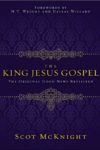
Most of evangelism today is obsessed with getting someone to make a decision; the apostles, however, were obsessed with making disciples. Those two words – decision and disciples – are behind this entire book.
Evangelism that focuses on decisions short circuits and – yes, the word is appropriate – aborts the design of the gospel, while evangelism that aims at disciples slows down to offer the full gospel of Jesus and the apostles. (p17, McKnight, S., The King Jesus Gospel: Tho Original Good News Revisited, Review)
Don’t get me wrong. The gospel should refer to aspects salvation when being applied to bring about a sinners conversion. However defining the gospel in terms of salvation will always narrow and limit its range of applications.
Blog
The general pattern of how I will approach most texts in the Old Testament will follow this sequence:
- Passage with comments
- Tie it into the Story of Israel,
- Tie it into the Story of Jesus (the Gospel),
- Apply the message to my readers (Salvation, Discipleship, Encouragement, Proclamation, etc).
Because that’s how I see the apostles structure their sermons and preach the gospel.
Copyright © Joshua Washington and thescripturesays, 2014-18. All Rights Reserved.
